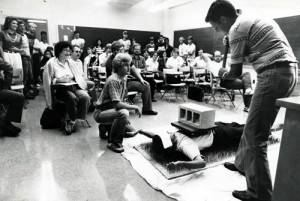Architectural history is not just about icons like Biltmore, the Robie House or the Lipstick Building. More modest, utilitarian structures also speak volumes about significant changes in Americans’ lifestyles and aspirations. Take, for instance, the Cardinal Motel, which sits on the Highway 31-W Bypass in Bowling Green. Like the Bypass itself, the Cardinal was a product of the automobile age, when vacationing families looked not only for someplace comfortable to spend the night but for entire districts catering to tourists where they could eat, shop and play.
By the 1940s, motel architecture had evolved from tourist camps and cabins to become more standardized, but visibility and functionality were the keys to attracting guests. With their communal “U”-shaped layouts, ample parking and low, horizontal lines, motels like the Cardinal promised convenience and economy for travelers. Even more important, perhaps, was signage–in the case of the Cardinal Motel, neon lettering and a giant statue of Kentucky’s state bird, the cardinal–designed to catch the eyes of passing motorists. Once inside, guests could expect comforts beyond those of home–not just television and air conditioning, but a swimming pool, ice machine and “magic fingers” vibrating mattresses. Eventually, however, the construction of I-65 and the rise of chain motels shifted the locus of tourist business away from the Bypass and the Cardinal.
Bowling Green’s Cardinal Motel is the subject of an architectural history paper written by WKU student Samantha Pillar and now part of the collections of WKU’s Special Collections Library. Click here for a finding aid. For more information about our collections, search TopScholar and KenCat.









